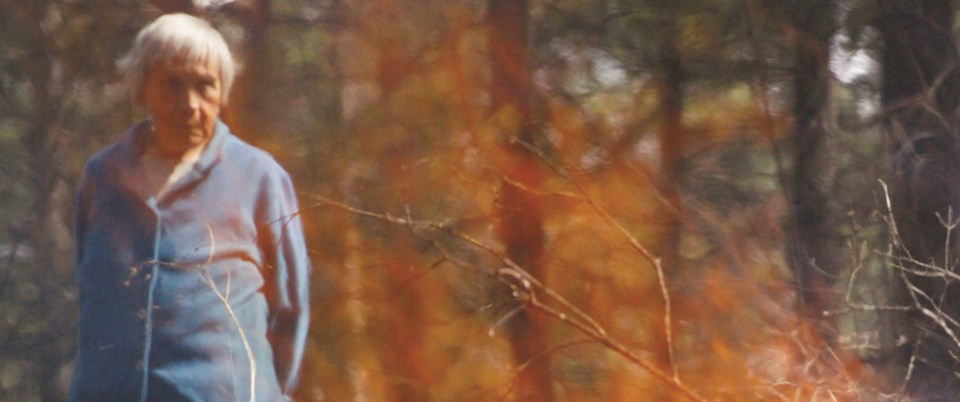An exclusive screening next week of the latest documentary feature by Sunshine Coast filmmakers Nova Ami and Velcrow Ripper is guaranteed to be the hottest ticket in town.
Their movie Incandescence — which has so far played to audiences at a handful of film festivals — is an unflinching examination of wildfires.
Ami and Ripper weave immersive on-the-ground footage together with first-person accounts from Indigenous Elders, first responders, and ordinary people forced to react to rapidly changing ecosystems.
When the duo pitched their vision to the National Film Board, the project kindled interest for its unique approach. Instead of a typical torn-from-the-headlines firefighting saga, the documentary follows the cycle of the seasons and captures fire’s enduring patterns of destruction, aftermath, and rebirth.
Plants and animals have adapted to use fire as part of their life cycle. Some tree species require heat to release their seeds, while other fire-activated plants make use of the nutrients released in the soil bank to bloom. The film documents tales of survival and adaptation through closeup depictions of human and non-human forest inhabitants, ranging from the flightpath of bees to an osprey’s aerial perspective.
While destructive mega-fires grow increasingly common around the globe, it was on a local beach — Bonniebrook — that the idea for the film was first sparked, seven years ago. “We were socked in that summer by wildfire smoke,” Ami recalled. “It was supposed to be a beautiful, sunny day, but it was gray and cloudy. The fire was very far away but it was one of the first times that we actually felt the direct impacts of wildfires.”
As they prepared for the film to enter production, the pair realized they knew a lot about dangerous, catastrophic forest fires — but next to nothing about “good” fire. “We started to learn more about it,” said Ripper, “and actually did some pre-interviews with cultural burners and firekeepers. We realized that this is really an important dimension that needs to be explored, because this ancient wisdom is very applicable to current times as well.”
They built a relationship with members of the Okanagan Nation, and captured the inaugural full collaboration between the BC Wildfire agency and the snpink’tn (Penticton) Indian Band in the course of executing a prescribed burn. Prescribed burns are an ancient technique that uses low-intensity fires to clear away fuel and protect communities from out-of-control mega-fires.
Response to wildfires is shown from more than just a human-centric perspective. The pair chose the beaver (“known as nature’s firefighter,” said Ami) to illustrate how animals build ecological resilience. Beavers create wetlands, which are natural barriers to the spread of wildfires. Some Indigenous groups also ascribe animal-like attributes to fire itself. “Indigenous people in the film talk about how they see fire as a creature,” said Ripper. “It’s like a sneaky coyote that you see in the distance. You see the smoke in the distance, and then it sneaks up on you.”
Ami and Ripper made the stylistic choice to eliminate “talking head” shots from the documentary film. Instead, interviewees are heard speaking over illustrative clips, often incorporating close-up footage of wildfires (including front-line views of the 2021 Monte Lake conflagration). Another bold decision was the choice to eliminate a music score altogether. “There’s no composer for this film,” explained Ripper. “There’s just myself as a sound designer and [Sunshine Coast guitarist and percussionist] Celso Machado who recorded all kinds of different sound effects with rainsticks and making the sound of fire with different objects.”
The effect is enthralling. The fire scenes are simultaneously beautiful and terrifying, depicted with immediacy that reflects the urgency of the global climate crisis. But through the filmmakers’ distinctive style (recently seen in the 2022 documentary Living with Dying they directed for the Sunshine Coast Hospice Society), catastrophe is tempered by hope.
In the film, West Kelowna fire chief Jason Brolund observes that firefighters can’t be on the front lines of climate change. “We need to actually start working as a community to protect our communities before fires come through,” said Ripper.
The April 19 screening of Incandescence will take place at the Raven’s Cry Theatre in Sechelt. The event is sponsored by Serve Your Swiya, a reconciliation initiative created and led by tsain-ko Development Corporation. The event will include an introduction from shíshálh Nation leaders and feature a keynote presentation from Sunshine Coast FireSmart leader David McIlwraith.
Attendees will also be offered an opportunity to volunteer in a fire mitigation project scheduled for May 3 (an all-day FireSmart cleanup at the shíshálh Nation Longhouse), which will be followed by a community barbecue at Ted Dixon Park.
Admission for the April 19 screening is free; filmmakers Ami and Ripper will be in attendance for an audience discussion.



